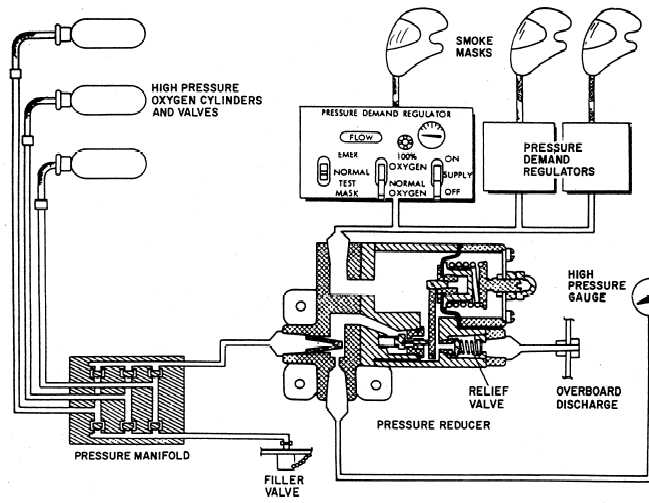The volume of any gas compressed in a cylinder
is directly proportional to the pressure. If the
pressure is half, the volume is half, etc. Therefore,
if 900 psi of oxygen remains in an 1,800 psi
system, half the oxygen is left.
A pressure gauge is always mounted at each
flight station, usually on the regulator. These
gauges are calibrated to indicate from 0 to 2,000
psi on high-pressure systems and 0 to 500 psi on
reduced high-pressure systems.
TYPICAL GASEOUS
OXYGEN SYSTEMS
As previously stated, naval aircraft equipped
with high-pressure oxygen systems are designed
for approximately 1,800 psi, and working
pressures reduce to 60 to 70 psi by a reducer or
regulator. Systems equipped with pressure
reducers are referred to as reduced high-pressure
systems. The reduced high-pressure gaseous
oxygen system shown in figure 4-5 is typical of
such systems. Oxygen is stored in three high-
-pressure cylinders and supplies three regulators—
one each for the pilot, copilot, and flight engineer.
SYSTEM OPERATION
The pressure manifold, which is equipped with
internal check valves, receives oxygen flow from
the cylinders, directs the flow into a common line,
and routes it to the pressure reducer. The
manifold assembly also connects to a filler line,
allowing the three cylinders to be recharged
simultaneously from an external supply. The
pressure reducer decreases the pressure to 65 psi.
Incorporated on the low-pressure side of the
pressure reducer is a relief valve, which connects
Figure 4-5.—Reduced high-pressure oxygen system schematic,
4-8



